Agile software development teams have long become a trend and only continue to gain popularity. Do you know what an agile software development model is and what benefits it brings? If not, read our article on The Pros and Cons of the Agile Approach from the CTO’s Perspective.
An agile team can make all the development processes faster and less expensive. But you need to work on the organization and distribute roles properly.
In this article, we’ll talk about the benefits of agile teams, possible types of structure, and how to recruit the best developers team for a project.
Agile approach in software development
Let’s start by looking at the structures that exist among agile software development teams. Agile teams’ specifications allow you to choose the type of organization that suits your particular business. Of course, each of them has its pros and cons.
Generalist
Generalists are people with a wide range of knowledge and experience. Generalists engage in the end-to-end development of a function or even an entire project. The general profile structure is the most popular model in the software outsourcing market. In layman’s terms, the generalist approach can be demonstrated using the formula:
one aspect of the project = one worker
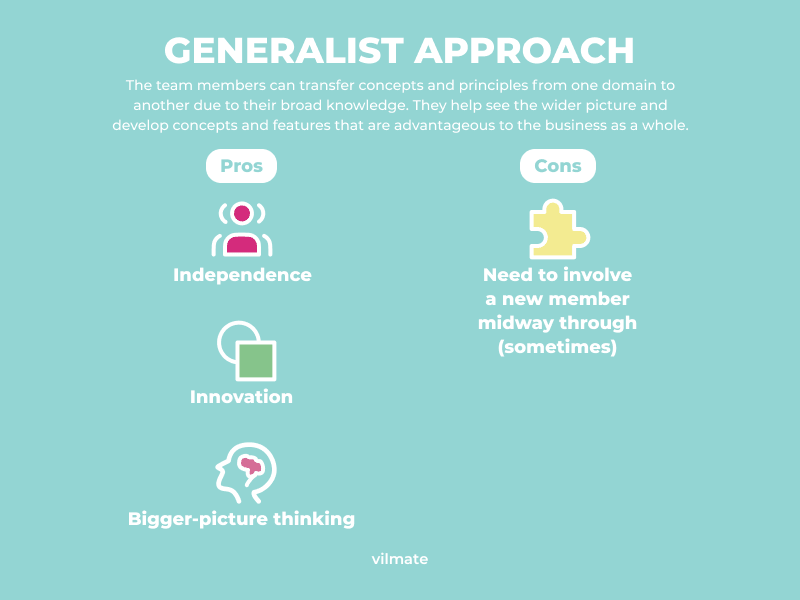
The benefit of the generalist method:
- All team members know how the product works. They will easily focus on a specific task and won’t distract other team members with questions. The participant will do their job from start to finish.
The disadvantage of the generalist method:
- The lack of some narrow, specialized knowledge suggests the involvement of new specialists to ensure smooth work on the project.
Specialist
The specialization structure involves experts, each of whom is responsible for a specific function. The specialist has very narrow tasks and responsibilities. Each project participant occupies a small niche in which he offers a top-level solution. At the same time, all participants depend on each other since they can realize the aspect only in the group.
Let’s represent the approach of a specialist in the form of a formula:
one aspect of the project = a group of experts
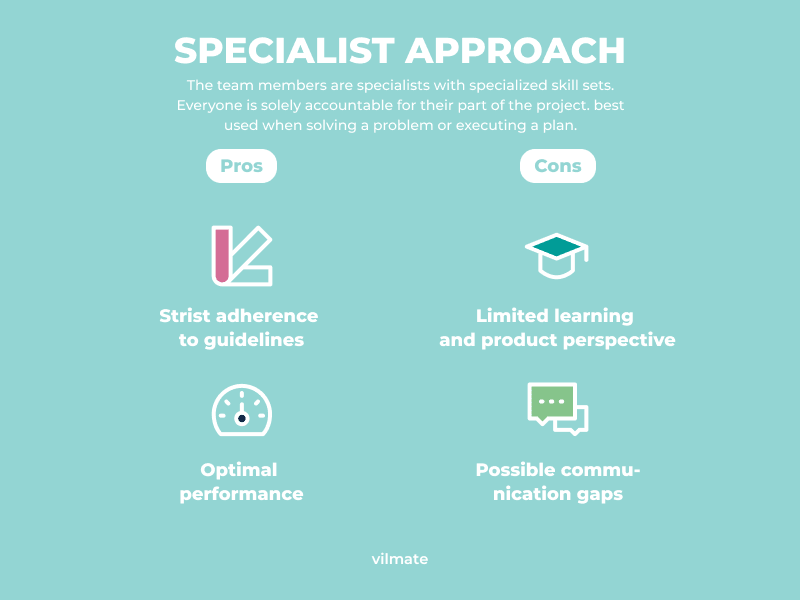
The advantage of a specialist structure:
- All tasks are performed at the utmost level, and a high-quality product is obtained without delay.
The disadvantage of the structure of specialists:
- Due to the narrow specialization of workers, not all parts of the project may be covered. There may be disagreements and communication gaps as experts don’t understand each other’s work aspects.
Hybrid
The hybrid structure of the software development team will allow you to combine all the advantages of the previous methods. In a hybrid structure, generalist workers supervise the execution of a specific task, drawing on the abilities of specialist experts. Of course, the hybrid method is the most flexible one.
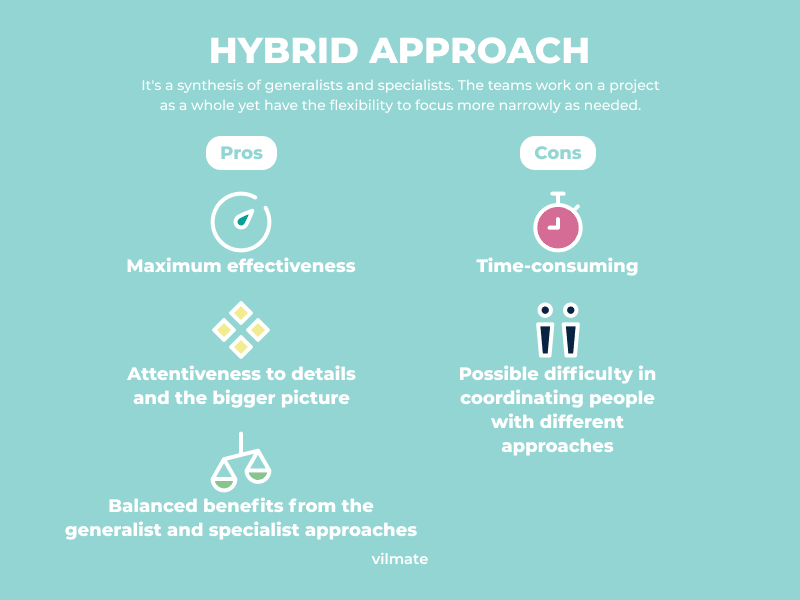
The advantage of the hybrid method is obvious:
- Specialists do high-end development, while generalists structure their work and make sure there are no gaps.
However, there are also disadvantages to the hybrid method:
- Building an effective hybrid team will take more time and a bigger budget. Also, specialists of different approaches may not immediately work together due to different views on work performance.
When putting together an agile software development team, you need to understand which people are best to work with. An agile team will become ideal when it stops demanding excessive control and can generate a product on its own. In the early stages, it may be necessary to hire coaching experts who can turn the recruitment of specialists of a wide or narrow profile into a coherent structure.
It seems that an agile software development team organization isn’t an easy task. So is it worth it? Let’s take a look at the key benefits of an agile team.
Characteristics of an agile team
According to statistics, 71% of companies use agile project management in the US. This is because this approach shows much better results, as well as a lower percentage of failures. Why are agile software development teams more successful?

- Independent project management
Each member of the agile team takes responsibility in their area. In an agile team, there’re no bosses and subordinates. There’re only fellow experts, each of whom is a valuable specialist in their field.
In an agile team, everyone is interested in the project’s success because their reputation and earnings depend on it. The immediate supervisor of the members of an agile software development team is the product owner. They formulate their requirements for the project participants.
- Cross-functional nature
The agile team method allows you to bring together the best specialists in all areas. All the professionals needed for a particular project can be integrated into the work, leaving no tasks unmet. Some experts’ skills complement others’ skills, and the team works to achieve the goal by diversifying tasks.
- Increased product quality
Since the agile team is recruited from scratch, all members are experts in their field. There are no extra members in an agile team, and each employee knows his job well. Moreover, specialists have a chance to focus on only one project and give all their strength to it.
Agile team vs. traditional team
The traditional team works according to the waterfall method, which implies a strict hierarchy. Such a system has a sufficient number of disadvantages:
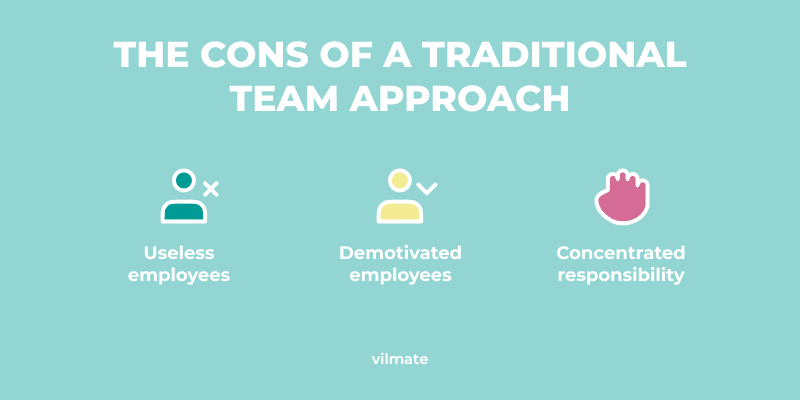
- Useless employees. In the waterfall system, certain managers take on a small load. Their tasks include only encouraging employees and monitoring processes. However, such an employee requires a large salary while bringing very little benefit.
- Demotivated employees. Being under constant control, the employee may feel like a less significant and authoritative member of the team. As a consequence, their useful skills will be lower. The goal of a waterfall employee is to get the title of a manager – not to show all their skills.
- Concentrated responsibility. In a traditional team, the manager is responsible for employees’ mistakes. While in an agile team, everyone is accountable for their processes. As a result, waterfall workers have no reason to give their all and worry about mistakes.
In an agile team, the manager deals with organizational issues, solves side tasks, and helps employees coordinate processes. A manager isn’t a boss but a colleague. Agile team members are referred to as “talent,” not “human resources.”
An agile team can be compared to an orchestra where every member contributes to the creation of a symphony. That is why large companies have already switched to an agile software development process. For example, Microsoft and IBM have long abandoned the waterfall structure.
Are you interested in choosing a distributed development team for your project? Let’s look at the main roles in agile software development.
Roles in an agile software development team structure
The typical size of an effective software development team is about 9 people. In any case, 3 main roles should be distinguished.
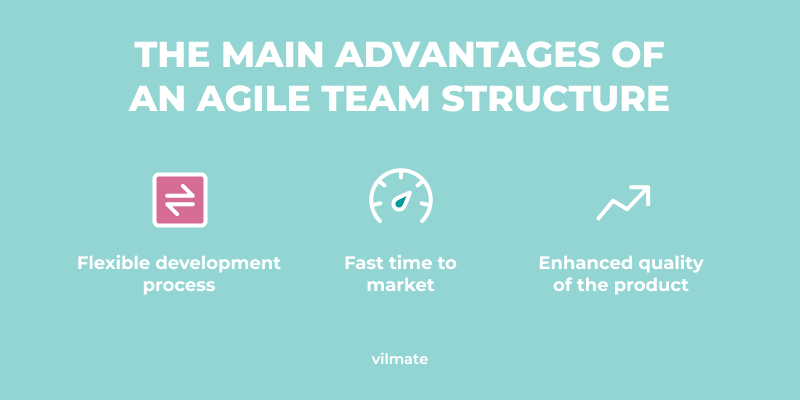
Product Owner (PO)
The product owner is the most interested participant in the project. The PO must have deep knowledge of the project structure and be responsible for the internal side of the development.
The main task of PO is to understand whether customers will like the finished version. Therefore, this participant must set tasks and priorities, approve and reject solutions, and make decisions on budget allocation. Thus, the PO is responsible for major project management tasks.
Scrum Master (SM)
Scrum’s agile methodology helps team members self-organize and adapt to new challenges. The scrum master is the curator of this process, being a manager responsible for communication.
The job of SM is to facilitate the work of employees and to distribute tasks so that an agile team doesn’t have to find tasks for itself. The Scrum framework is the most popular among software development teams because it eliminates misunderstandings along the way.
Agile development team
The development team consists of people who work together on the project. The traditional agile team includes frontend, backend developers, UX/UI designers, and quality assurance engineers (QA).
The remaining roles are variable and depend on the tasks. Perhaps the specifics of the product will require the involvement of other specialists. Such workers may work part-time or perform a specific project. At the same time, such an employee usually doesn’t bear responsibility for the success of the project.
But it’s better to avoid having temporary team members. A scrum team involves finding a development team that can cover all tasks and will be provided with work during the entire working time.
Is an agile software development team right for your business?
To understand if the agile development approach is right for you, answer a few questions:
- Are you ready to take responsibility for your project and formulate requirements yourself?
- Do you want specialists to develop without requiring your participation in all aspects?
- Can you break away from traditional thinking and try a new software development methodology?
If you can answer “yes” to all questions, then an agile development team is right for your business. And it has a lot of advantages to bring:
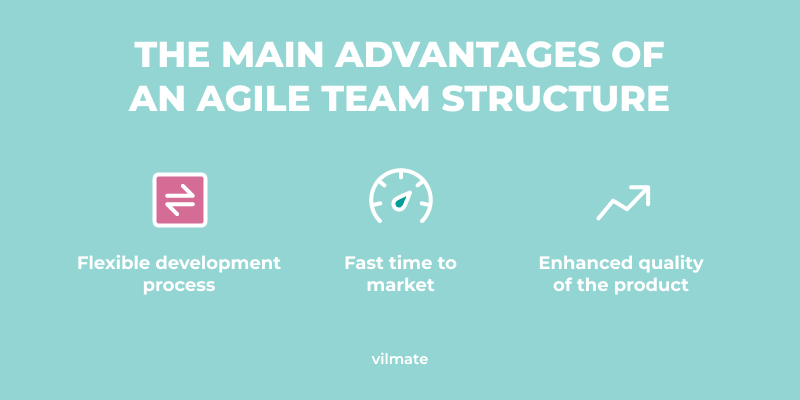
- Flexible product development process
The essence of an agile team is that adjustments are made during the development process. Responding immediately to PO or customer requirements is the norm for an agile development team. This approach saves time and money because late edits are more difficult to implement. In addition, the QA team works together with the development team, testing the product at every stage and not at the end.
- Fast time to market
All employees are professionals, and there are no intermediaries in their communication. Changes are being implemented immediately, so the work time is reduced.
- Enhanced quality of the product
Professionals who are result-oriented and know their business do the job quickly and efficiently. They’re interested in the quality of the project because of their reputation among colleagues and future employers. Since all members of the agile team are experts, they will be able to help each other and provide support.
- Improved cost-efficiency
An agile product development process involves spending only on the necessary tasks. Also, cost savings follow from the previous points: saving time and better capitalization of a quality product cut the costs significantly.
However, if you or your team have no experience with the agile approach, you may face some communication difficulties at the initial stage. It happens because different people need to get used to each other and realize mutual possibilities. Nevertheless, these challenges are temporary.
Have you decided to opt for an agile team? Then it’s time to start building a development team for your project.
How to build an effective agile software development team
To understand how to create an effective development team, let’s look at how to assemble an agile team to help your project fly high.
The fundamentals of building an agile team
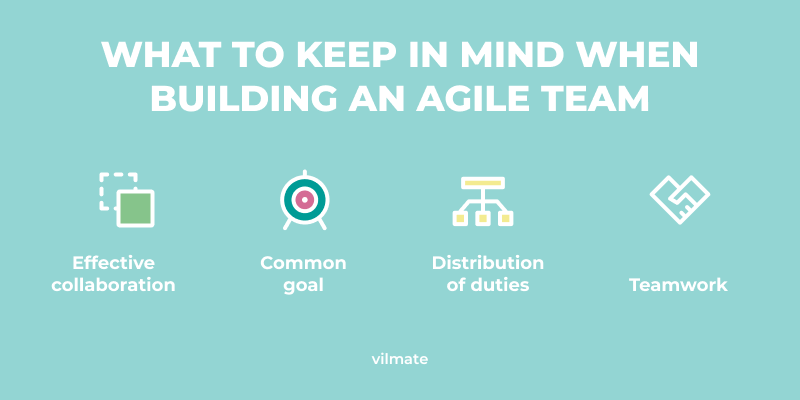
- Effective collaboration
Team members play an important part in it. They understand exactly what they are working on, report about possible obstacles, and are ready to communicate.
- Common goal
Working together, members of an agile team move towards the desired outcome. After completing their part of the work, employees notice the actions of colleagues in the project management tool’s dashboard, ready to continue the work on a certain task.
- Distribution of duties
Each member of the product development team has their tasks, and they aren’t superimposed by others. Roles are assigned from the very beginning of the project and cannot change in the middle of it.
- Teamwork
The values of a software development company will allow different specialists to unite. A well-formulated idea and corporate culture can rally developers and make their work productive.
Finding the right people
When looking for agile software developers, you should pay attention to the following aspects:
- Co-location. If the team is located in the same place, then communication will be faster. It also has a huge impact on team productivity.
- Motivation. Each member of the agile team must have a stake in the project. It’s also important that employees are focused on only one product, and their attention isn’t distracted by other projects.
- Cohesion. If you turn to an existing outsourcing team whose members have been working together for a long time, you can significantly reduce the time for training and setting up communication.
To diminish the risks of your team not meeting the aspects above, you can turn to a seasoned outsourcing company. We’ve discussed the main aspects of picking a partner that will suit your needs in our previous article: Checklist: How to choose the right outsourcing company for an IT project.
When looking for an agile outsourced team, you’ll face another choice. Here, you’ll need to choose from nearshore developers, offshore developers, and onshore developers.
Onshore team
An onshore team is an agile team that is localized directly in your country. This is the most expensive niche that won’t be able to provide sufficient cost savings. Onshore teams are only chosen by employers who want to be involved at the deepest level.
Nearshore team
The nearshore team is an agile team that is based in another country but can communicate in your language and in the same time zone (± 1h). This is the best choice for the product owner because it saves money while maintaining the quality of the work. The developers are always in touch and understand the wishes of the customer well.
Vilmate specialists collaborate with European clients using this model. Thus, they get a well-coordinated nearshore team that can develop a product that will meet their needs. You can see examples of fruitful cooperation our team had in our Portfolio.
Offshore team
And finally, let’s talk about offshore teams. They’re assembled by companies located in different time zone and also ask for the lowest cost for their services. Recently, the line between offshore and nearshore development teams has blurred, as agile teams from all countries have deep knowledge of English and are ready to work at the right time, regardless of the time of day.
Bottom line
We’ve figured out what an agile software development structure is and why this method has almost no disadvantages in most cases. An agile team structure allows you to create a great product while saving money and time.
If you are looking for a development team that can implement your project in an agile manner, the Vilmate team is ready for cooperation. The Vilmate team consists of IT specialists who’ve passed a stringent selection process to be ready to offer extensive software engineering expertise and reliability for your software development project.
Contact us to find out how we can help boost your software development productivity and results!




